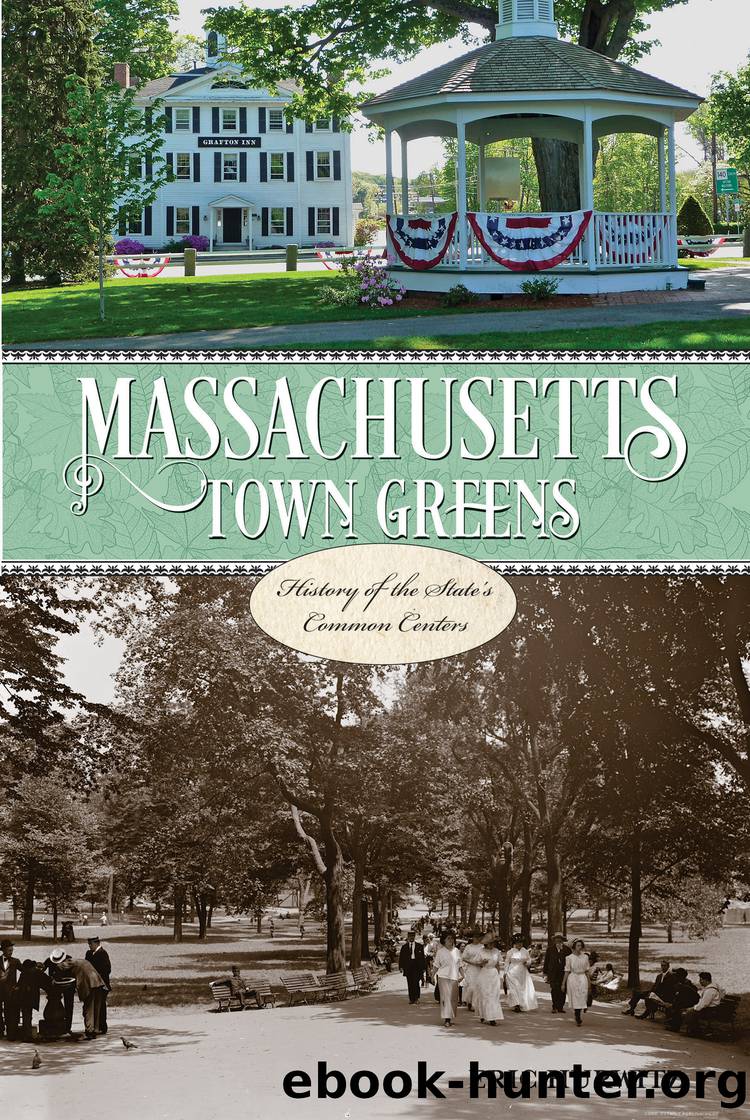Massachusetts Town Greens by Hurwitz Eric;

Author:Hurwitz, Eric; [Hurwitz, Eric]
Language: eng
Format: epub
Publisher: Globe Pequot
Published: 2016-06-15T00:00:00+00:00
Historic buildings surround Lawrence Common.
During the creation of the Lawrence Town Common and Historic District, the Essex Company eliminated 6.7 miles of rocks and trees, while putting brooks underground to create the blueprint of the cityâs new heart and soul, according to Jonas A. Stundzia, city historian and chairman of the Lawrence Historical Commission.
With Storrow setting the foundation for the Lawrence Common, the city then brought in Frederic Law Olmsted as a design star to create the Victorian Promenade-style of the town green that, to this very day, has a timeless appeal. Itâs interesting to note that the Victorian style wasnât exactly Olmstedâs cup of tea, but the City of Lawrence knew they had a master on their hands and that he also happened to be an expert in dealing with problematic water tablesââan issue Lawrence experienced in parts of the open land.
Stundzia says that during the early days of the Lawrence Town Common, the presence of a massive line of elm trees planted in 1850 provided further beauty to the open land.
âIt was like walking in a jungle,â says Stundzia.
The trees, unfortunately, succumbed to Dutch elm disease, starting in 1918, thus eradicating an attractive element of the Lawrence Common. The Lawrence Common nevertheless stayed true to its original vision, offering a beautiful open space for residents to enjoy. The green did run into some maintenance problems during the 1970s, however, when the decline of local industries had a deleterious effect on the city as a whole.
âFortunately, placement on the National Register of Historic Places gave the area some legs,â says Stundzia, and the Lawrence Town Commonâs temporarily lost attractive looks came back.
The Lawrence Town Common is known today, by many, as Compagnone Park, although the commonâs original moniker holds near and dear to the hearts among longtime residents, historians, and other traditionalists. The Compagnone brothers of Lawrence gave their lives during World War II.
The common features many memorials and monuments in dedication to those who served and paid the ultimate price for defending our freedoms. The 1881 Civil War memorial lists the names of Lawrence men who fought for the Union. The green also showcases World War II, SpanishâAmerican War, Gulf War, and Korean War memorials.
Modern-day amenities: a fenced baseball field with a dugout and spectator seating; the Robert Frost Fountain for scenery and relaxation across from Lawrence City Hall; and a playground on the Jackson Street side with a slide, swings, a jungle gym, and monkey bars.
For added historical authenticity, many civic buildings face the town green including âlate 19th-century Romanesque and Queen Anne styles (that) mix with later Colonial and Classical Revival buildings on Essex Street, one block removed from the Common,â according to the 1986 MHC Reconnaissance Survey Town Report of Lawrence.
Stundzia points out that a âgem of nineteenth-century buildingsâ and an âeverything is right thereâ vision of this historic area features Unitarian and Baptist churches, a Masonic building, a public library, a grammar school, Lawrence City Hall, and a court house, for starters.
âItâs a microcosm of the urbanization of a city,â says Stundzia.
Download
This site does not store any files on its server. We only index and link to content provided by other sites. Please contact the content providers to delete copyright contents if any and email us, we'll remove relevant links or contents immediately.
Giovanni's Room by James Baldwin(6814)
The Plant Paradox by Dr. Steven R. Gundry M.D(2430)
The Stranger in the Woods by Michael Finkel(2330)
Miami by Joan Didion(2166)
Wild: From Lost to Found on the Pacific Crest Trail by Cheryl Strayed(2134)
INTO THE WILD by Jon Krakauer(2086)
Trail Magic by Trevelyan Quest Edwards & Hazel Edwards(2063)
DK Eyewitness Top 10 Travel Guides Orlando by DK(2058)
Vacationland by John Hodgman(2033)
The Twilight Saga Collection by Stephenie Meyer(2029)
Nomadland by Jessica Bruder(1960)
Birds of the Pacific Northwest by Shewey John; Blount Tim;(1876)
The Last Flight by Julie Clark(1833)
Portland: Including the Coast, Mounts Hood and St. Helens, and the Santiam River by Paul Gerald(1820)
On Trails by Robert Moor(1794)
Deep South by Paul Theroux(1718)
Blue Highways by William Least Heat-Moon(1664)
Trees and Shrubs of the Pacific Northwest by Mark Turner(1645)
1,000 Places to See in the United States and Canada Before You Die (1,000 Places to See in the United States & Canada Before You) by Patricia Schultz(1558)
